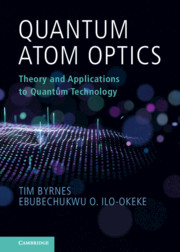Refine search
Actions for selected content:
2 results
15 - The Resource Theory of Asymmetry
- from Part V - Additional Examples of Static Resource Theories
-
- Book:
- Quantum Resource Theories
- Published online:
- 03 May 2025
- Print publication:
- 10 April 2025, pp 673-735
-
- Chapter
- Export citation

Quantum Atom Optics
- Theory and Applications to Quantum Technology
-
- Published online:
- 23 July 2021
- Print publication:
- 05 August 2021
